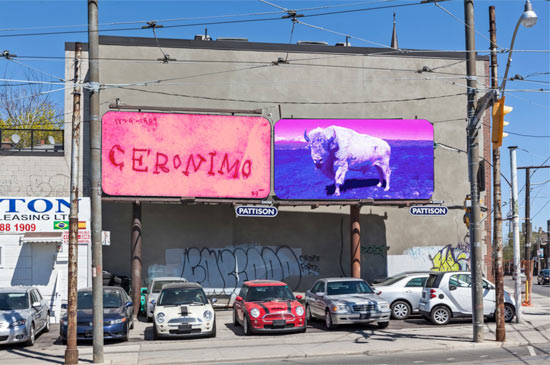Dana Claxton: Indian Candy
 Dana Claxton. Contact billboards, Dundas Street West, Toronto. left, Geronimo in Pink, 2013; right Tantanka (buffalo) 2013
Dana Claxton. Contact billboards, Dundas Street West, Toronto. left, Geronimo in Pink, 2013; right Tantanka (buffalo) 2013
Dana Claxton is one of the exhibitors at Scotiabank Contact this year, and three of her works are on billboards on Calgary's 9th Avenue SE: on my corner is Sitting Bull's signature taken from a postcard handed out by Buffalo Bill's Wild West Show, where such troubling heroes had become exhibitions.
The billboards are owned by Pattison, and the exhibition of Contact works is part of Pattison's Art in Transit programme. May and June each year are a treat, as our same billboards always have Contact works, and then they go back to being commercials. Would it be too much for Pattison to denote these billboards as permanent sites for photographs from the best of Canada's artists? It gives so much to think about, these beautiful and provocative images.
Claxton's billboard images are drawn from her series Indian Candy, chromogenic prints on aluminum of the clichés of the 'wild west' indian: Tonto, Geronimo, Maria Tallchief in exotic headdress, a buffalo, writing on stone petroglyphs, Sitting Bull, a feathered war bonnet, a ledger drawing, all taken from the vast archive that is the net, pixellations and all, and then washed in bright candy-coloured chemical colours. The narrative line is the ambiguity between history and popular culture, the Wild West Show exemplifying the confusion: were the Indian Wars, the stock in trade of the western movie, history or entertainment? After Little Bighorn, Sitting Bull crossed the border into Saskatchewan, living there for five years. Claxton's reserve is Wood Mountain First Nation and is descended from Sitting Bull's people.
It is interesting that actual location of all the original pieces she uses are in various archives – where doesn't matter as they can all be found on the web, somewhere, copied and re-assembled, manipulated, emphasised, re-arranged. The validity of the images is not in the contiguity of evidence, original piece next to original piece that traditionally makes a good archival collection. Their validity is that the images circulate in the public domain, and someone has pulled pieces together to say something. The order in which the fragments of evidence are shuffled tells particular histories: the way the US Department of the Interior arranged them both demonises and patronises Sitting Bull's resistance to colonisation; the way Claxton recontextualises the same pieces tells the aftermath.
